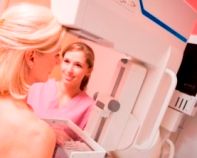Better Understanding of Screening Mammography Cuts Imaging Rates Among Older Women
With more details about benefits and harms of annual screening, fewer women opt for the study.

Older women who know more about the possible harms and benefits of breast cancer screening are actually less likely to get a routine mammogram, according to a new study.
Based to a randomized trial, published in JAMA Internal Medicine, annual screening mammography in women over age 75 dropped by nearly 10 percent when the patients knew more about the procedure. These women were able to make a more informed decision, potentially reducing over-screening, wrote the research team led by Mara Schonberg, M.D., MPH, associate professor of medicine at Harvard Medical School of Beth Israel Deaconess Medical Center.
Currently, guidelines recommend against annual screening mammograms for women who might have less than a 10-year remaining lifespan. But, 56 percent of women over age 75 report still getting the routine test, Schonberg said in an audio interview. And, while little evidence of screening efficacy exists in this population, the pain, anxiety, false positives, and potential over-diagnosis and over-treatment are known factors.
“Often those practice-based programs aren’t changed for women age 75 and older, so often women think they are supposed to continue getting screened,” she said.
To determine whether added information about screening mammograms affected an older woman’s decision to receive the test, investigators provided a paper-based decision aid, filled with breast cancer risk factors, sociodemographic characteristics, and screening intentions, to 546 women between the ages of 75 to 89 before they met with their primary care provider. After reading the information, only 51.3 percent decided to undergo a mammogram. Among a control group, who received a home safety pamphlet, 60.4 percent opted for a mammogram.
“Providing women 75 years and older with a mammography screening decision aid before a primary care visit helps them make more informed screening decisions and leads to fewer women choosing to be screened,” Schonberg wrote in the study.
After reading the mammography decision aid, patients reported the tool changed their perspectives about the screening test. They reported a better understanding of screening harms and benefits than women in the control group, 25.5 percent and 11.7 percent respectively. And, they also said they were less likely to receive another screening than they had been during their previous doctor’s appointment – 24.5 percent versus 15.3 percent among the control group. Additionally, the decision tool increased the likelihood (47.4 percent and 38.9 percent, respectively) that they would talk with their provider about screening.
Support for Forgoing Screening
In an accompanying editorial, Joann Elmore, M.D., MPH, an internal medicine specialist with the David Geffen School of Medicine at the University of California at Los Angeles, and Q. Ngo-Metzger, M.D., MPH, a professor of health systems science with Kaiser Permanente’s Bernard J. Tyson School of Medicine, pointed to simulation mammography models conducted with women in this age group. According to the average risk with a normal life expectancy, in this age group, screening mammography will likely prevent one breast cancer death for every 1,000 women screened. But, it could simultaneously produce up to 96 false positives, as well as one cases of over-diagnosis.
It could also take a long time for women age 75 and older to see the benefits of screening mammography.
“Research on the time required for screening to result in benefit suggests that it takes 10 or more years before breast cancer deaths are prevented,” Elmore and Ngo-Metzger wrote in the editorial. “In contrast, the potential harm from screening, such as false-positive test results, unnecessary biopsies and complications from biopsies, potential over-diagnosis and overtreatment, occurs immediately.”
Ultimately, according to Schonberg’s study results, most women found the decision aid tool to be beneficial with 94.9 percent reporting they would recommend it to other women facing the same choice about screening mammography.
“The decision tool…was found to be helpful, improved knowledge, and discussions about mammography, and led to fewer women aged 75 and older being screened,” Schonberg wrote. “Older women should have the opportunity to make informed screening decisions based on their values and a realistic understanding of the benefits and harms of mammography.”
AI-Initiated Recalls After Screening Mammography Demonstrate Higher PPV for Breast Cancer
March 18th 2025While recalls initiated by one of two reviewing radiologists after screening mammography were nearly 10 percent higher than recalls initiated by an AI software, the AI-initiated recalls had an 85 percent higher positive predictive value for breast cancer, according to a new study.
ECR Mammography Study: Pre-Op CEM Detects 34 Percent More Multifocal Masses than Mammography
February 28th 2025In addition to contrast-enhanced mammography (CEM) demonstrating over a 90 percent detection rate for multifocal masses, researchers found that no significant difference between histological measurements and CEM, according to study findings presented at the European Congress of Radiology.
Study: Mammography AI Leads to 29 Percent Increase in Breast Cancer Detection
February 5th 2025Use of the mammography AI software had a nearly equivalent false positive rate as unassisted radiologist interpretation and resulted in a 44 percent reduction in screen reading workload, according to findings from a randomized controlled trial involving over 105,000 women.